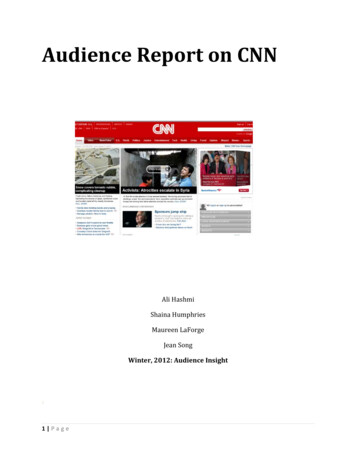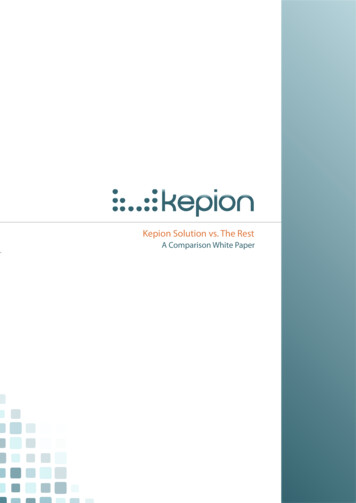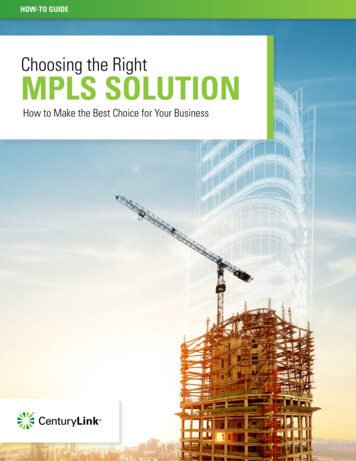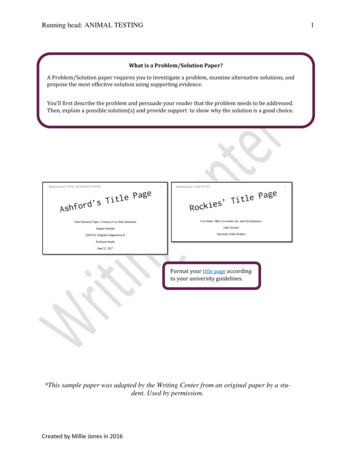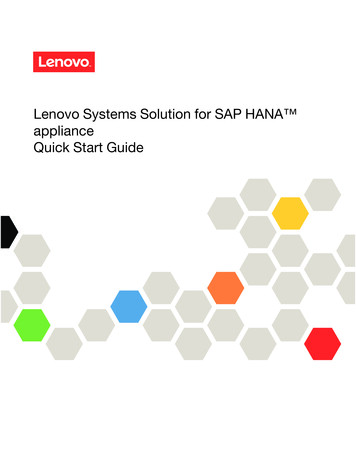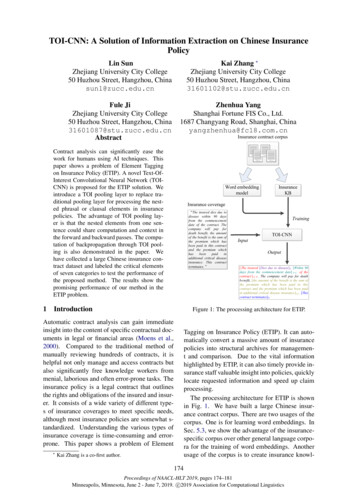
Transcription
TOI-CNN: A Solution of Information Extraction on Chinese InsurancePolicyLin SunZhejiang University City College50 Huzhou Street, Hangzhou, Chinasunl@zucc.edu.cnKai Zhang Zhejiang University City College50 Huzhou Street, Hangzhou, China31601102@stu.zucc.edu.cnFule JiZhejiang University City College50 Huzhou Street, Hangzhou, China31601087@stu.zucc.edu.cnAbstractZhenhua YangShanghai Fortune FIS Co., Ltd.1687 Changyang Road, Shanghai, Chinayangzhenhua@fc18.com.cnInsurance contract corpusContract analysis can significantly ease thework for humans using AI techniques. Thispaper shows a problem of Element Taggingon Insurance Policy (ETIP). A novel Text-OfInterest Convolutional Neural Network (TOICNN) is proposed for the ETIP solution. Weintroduce a TOI pooling layer to replace traditional pooling layer for processing the nested phrasal or clausal elements in insurancepolicies. The advantage of TOI pooling layer is that the nested elements from one sentence could share computation and context inthe forward and backward passes. The computation of backpropagation through TOI pooling is also demonstrated in the paper. Wehave collected a large Chinese insurance contract dataset and labeled the critical elementsof seven categories to test the performance ofthe proposed method. The results show thepromising performance of our method in theETIP problem.1Word embeddingmodelInsurance coverage“ The insured dies due todisease within 90 daysfrom the commencementdate of the contract. Thecompany will pay fordeath benefit, the amountof the benefit is the sum ofthe premium which hasbeen paid in this contractand the premium whichhasbeenpaidinadditional critical diseaseinsurance. This nputOutput[[TheThe insuredinsured [Dies[Dies duedue toto disease]disease]CC [Within[Within 9090daysdays fromfrom thethe commencementcommencement date]date] PP CC ofof thethecontractcontract ]] CC PP . TheThe companycompany willwill paypay forfor deathdeathbenefit,benefit, [the[the amountamount ofof thethe benefitbenefit isis thethe sumsum ofofthethe premiumpremium whichwhich hashas beenbeen paidpaid inin thisthiscontractcontract andand thethe premiumpremium whichwhich hashas beenbeen paidpaidinin additionaladditional criticalcritical diseasedisease insurance]insurance]IA[ThisIA. [Thiscontractcontract terminates]terminates]TT.Figure 1: The processing architecture for ETIP.Automatic contract analysis can gain immediateinsight into the content of specific contractual documents in legal or financial areas (Moens et al.,2000). Compared to the traditional method ofmanually reviewing hundreds of contracts, it ishelpful not only manage and access contracts butalso significantly free knowledge workers frommenial, laborious and often error-prone tasks. Theinsurance policy is a legal contract that outlinesthe rights and obligations of the insured and insurer. It consists of a wide variety of different types of insurance coverages to meet specific needs,although most insurance policies are somewhat standardized. Understanding the various types ofinsurance coverage is time-consuming and errorprone. This paper shows a problem of Element InsuranceKBTagging on Insurance Policy (ETIP). It can automatically convert a massive amount of insurancepolicies into structural archives for management and comparison. Due to the vital informationhighlighted by ETIP, it can also timely provide insurance staff valuable insight into policies, quicklylocate requested information and speed up claimprocessing.The processing architecture for ETIP is shownin Fig. 1. We have built a large Chinese insurance contract corpus. There are two usages of thecorpus. One is for learning word embeddings. InSec. 5.3, we show the advantage of the insurancespecific corpus over other general language corpora for the training of word embeddings. Anotherusage of the corpus is to create insurance knowl-Kai Zhang is a co-first author.174Proceedings of NAACL-HLT 2019, pages 174–181Minneapolis, Minnesota, June 2 - June 7, 2019. c 2019 Association for Computational Linguistics
et al., 2017) by rule-based layout detection. Azzopardi et al. (2016) developed a mixture extraction method of regular expressions and named entity to extract information from contract clauses,and provided an intelligent contract editing tool tolawyers. Previous works of contract informationextraction always focused on title, date, layout,contracting party, etc. They are not directly related to the semantics of contracts, and could notprovide deep insight into contract understanding.The insurance policies are formal legal documentsand usually have general elemental compositions,e.g., coverage, payment, and period. In this paper,we investigate how to interpret insurance clauses.Some examples of ETIP are shown in Sec. 3.The tasks of information extraction could beNamed Entity Recognition (NER) (Nadeau andSekine, 2007; Ritter et al., 2011), Information Extraction by Text Segmentation (IETS) (Cortez andDa Silva, 2013; Hu et al., 2017), etc. NER typically recognizes persons, organizations, locations, dates, amounts, etc. IETS identifies attributesfrom semi-structured records in the form of continuous text, e.g., product description and ads. Theprevious IE works on contracts (Azzopardi et al.,2016; Chalkidis et al., 2017) are similar to NER.Recently researchers pushed the field of NERtowards nested representations of named entities.Muis and Lu (2017) incorporated mention separators to capture how mentions overlap with oneanother. Both of two works relied on hand-craftedfeatures. Ju et al. (2018) designed a sequential stack of flat NER layers that detects nested entities.One bidirectional LSTM layer represented wordsequences and CRF layer on top of the LSTM layer decoded label sequences globally. Katiyar andCardie (2018) presented a standard LSTM-basedsequence labeling model to learn the nested entity hypergraph structure for an input sentence. OurETIP problem is a variant of nested NER, calledlengthy nested NER. The type of nested entitiesvaries from phrase to clause. However, in the previous nested NER datesets (Kim et al., 2003; Doddington et al., 2004), the type of nested entities only contains short phrase and the average length isapproximately three words.edge base (KB). Insurance KB, which consists ofseven categories of the elements manually labeledby the insurance employees, provides the trainingdata for TOI-CNN model. Specifically, the contributions of this paper can be summarized as follows: To our best knowledge, this is the first workon semantic-specific tagging on insurancecontracts. Compared to nested NER, not only the type of the elements varies from a shortphrase to a long sentence, but also a phrase orclause element could be embedded in otherelements. We propose a novel TOI-CNN model for theETIP solution. The advantage of TOI poolinglayer is that the elements from the same sentence could share computation and context inthe forward and backward passes. We have collected 500 Chinese insurancecontracts of 46 insurance companies and published the dataset. The experimental results show that the overall performance of TOICNN is promising for practical application.2Related WorkThe work of contract analysis is typically dividedinto two categories, segmentation and informationextraction (IE). Segmentation (Hasan et al., 2008;Loza Mencı́a, 2009) aims to outline the structureof a conventional text format by annotating title,section, subsection, and so on. Information extraction (Cohen and McCallum, 2004; Piskorski andYangarber, 2013) focuses on the classification ofwords, phrases or sentences. Recent works of contract information extraction have addressed recognition of some essential elements in legal documents (Curtotti and Mccreath, 2010; Indukuri andKrishna, 2010). Chalkidis et al. (2017) extractedthe contract element, types of which are contracttitle, contracting parties, date, contract period, legislation refs and so on. The extraction method wasbased on Logistic Regression, SVM (Chalkidiset al., 2017) and BILSTM (Chalkidis and Androutsopoulos, 2017) with POS tag embeddings andhand-crafted features. Garcı́a-Constantino et al.(2017) presented the system called CLIEL for extracting information from commercial law documents. CLIEL identified five element categoriessimilar to the literature mentioned in (Chalkidis3ETIP Problem StatementIn this section, we first give the definition ofelements tagging on insurance policy (ETIP)problem. Given an insurance coverage C 175
1. [ 我们向您退还 [本合同终止时]T 的现金价值 ]IA[ We refund you the cash value when [this contract terminates ]T ]IA(s1 , s2 , ., sn ), where si is the ith sentence in C.si (wi,1 , wi,2 , ., wi,m ), where wi,j is the jthword in sentence si . An element e in the coverageC is continuous words in one sentence, denotedas e {(wi,s , wi,s 1 , ., wi,t ), l} , where l is thecategory label of the element e. The goal of ETIPis to find the element e of category l in the coverage C. We define seven categories of insuranceclauses listed as follows, Cover (C)2. [ 等待期是指本合同生效后 [ 平安人寿不承担保险责任 ]E 的一段时间 ]W P[ The waiting period refers to the period of [ no obligation for insurance benefits from Ping An life insurance ]E after the contract takes effect ]W P3. [ 若 被 保 险 人 在 本 合 同 生 效 之 日 起180日( [ 这180日的时间段称为“等待期” ]W P )内 [ 身故 ]C ]CP[ If [ the insured died ]C within 180 days ( [ this 180day period is called ”waiting period” ]W P ) from thecommencement date of the contract ]CP Waiting Period (WP) Period of Coverage (PC) Insured Amount (IA)4. [ 主合同的保险费 [ �日起 ]CP �险金额支付 ]IA[ The insurance benefits of the main contract will bepaid [ from the date of the first premiums paid afterthe payment of the insurance benefits ]CP according tothe premiums rate of the insured’s age and the basicinsurance amount ]IA Exclusion (E) Condition for Paymen Termination (T).t (CP)Here we give a coverage example in ETIPand translate it for English reading paper. Onecategory is represented by one kind of font color.To illustrate phrasal level of an element, we define a metric, called Element Length Ratio R The insured dies due to disease within 90 daysfrom the commencement date of the contract. Thecompany will pay for death benefit, the amount of thebenefit is the sum of the premium which has been paidin this contract and the premium which has been paidin additional critical disease insurance. This contractterminates.element length.sentence length(1)For example, ELR(C) 4/16 0.25,ELR(P C) 7/16 0.44, ELR(CP ) 1 inthe previous example. Tab. 1 in experiment section will list the statistics of ELR.4The extractable elements in the example arelisted as follows,TOI-CNN ArchitectureFig. 2 illustrates the TOI-CNN architecture. TOICNN takes as input an entire sentence and a setof elements. The network first processes the whole sentence with one convolutional layer (Conv Relu in Fig. 2) to yield 36 feature maps. Thenfor each element,the TOI pooling layer extracts afixed-length feature vector from the feature map.Each feature vector is fed into a sequence of fullyconnected (fc1) layer that finally connects the output layer, which produces softmax probability estimates over K element classes plus a non-elementclass. C: dies due to disease PC: within 90 days from the commencement date CP: The insured dies due to disease within 90 daysfrom the commencement date of the contract IA: the amount of the benefit is the sum of the premiumwhich has been paid in this contract and the premiumwhich has been paid in additional critical disease insurance T: This contract terminates.In this example, the sentence of CP in red contains the other two elements which are C in purpleand PC in green respectively. It is the challenge ofETIP, a general element tagging problem, whichallows that the elements of various length couldbe overlapped. We demonstrate other examplesin ETIP along with English translation as follows,where [ ]tag is a category tag labeling the range ofan element.4.1The Convolutional LayerWe use the CNN model (Kim, 2014) with pretrained word embedding (Mikolov et al., 2013) forthe convolutional layer. wi is i-th word in thesentence and is represented as the k-dimensionalword embedding vector. The dimension of the input layer is n k ( padding zeros when the lengthof the sentence is less than n ). Our neural network176
softmax(K 1) 1fc136 1TOI pooling72 1Conv ReLUfeature maps:36@5 3004.3.In TOI-CNN, training samples include two categories: 1) TOI ground truths, 2) negative slidingwindows. A sliding window is defined as negatives, or called non-element class, if IoU ( Intersection over Union ) with all ground truths of asentence is less than a threshold ths . FunctionIoU (a, b), measuring how much overlap occursbetween two text strings a and b, is defined as,.word embeddingsTraining Samples of TOI-CNN.IoU (a, b) 4.4w1 w2 w3 w4 w5 w6 w7 w8 w9 w10 w11 w12TOI(2)Backpropagation through TOI PoolingLayerThe network is modified to take two data inputs:a set of sentences and a list of training samples inthose sentences. Each training sample is given asa one-hot encoding label p (0, ., pj 1, ., 0)with a class j . The cross entropy loss L is,Figure 2: TOI-CNN architecture.consists of one convolution layer with ReLU activation and one TOI pooling layer, which replacesthe max pooling layer of CNN in general. Theconvolution layer has a set of filters of size h kand produces p feature maps of size (n h 1) 1.4.2length(a b).length(a b)L log p j ,(3)where p is the output of the softmax layer. Then,we present the derivative rules in backpropagationthrough the TOI pooling layer.Let xi be the i-th activation input into the TOIpooling layer and let ys,j be the layer’s j-th output from the s-th training sample. The TOI pooling layer computes ys,j max(xi ), xi Ws,j ,where Ws,j is the j-th input sub-window overwhich max-pooling outputs ys,j . Due to overlapsbetween training samples, a single xi may be assigned to several different outputs ys,j . Let M(xi )be the set of ys,j that xi activates in the TOI pooling layer.Finally, the TOI pooling layer’s backwardsfunction computes partial derivative of the lossfunction with respect to input variable xi as follows,X X L L , ys,j M(xi ).(4) xi ys,jsThe TOI Pooling LayerThe TOI pooling layer uses max pooling to convert the features inside any valid region of an interesting window into a small feature map witha fixed length of L ( e.g., L 2 in Fig. 2 ).Fig. 2 describes the TOI pooling in detail usingred lines and rectangles. The TOI pooling layerextracts text region of the elements from the feature maps of the convolutional layer. The TOI region is shown as a red rectangle in the input sentence, shown in Fig. 2. The corresponding TOIwindow in the feature maps is connected by redcurved lines. The length of the TOI window becomes shorter because of the narrow convolution.jTOI max pooling works by dividing the TOIwindow of length rl into L sub-windows of sizebrl/Lc and then max-pooling the values in eachsub-window into the corresponding cell of TOIpooling layer. For example, rl 6 in Fig. 2 andhence the sub-window of size 6/2 3 produce acell of the pooling layer. Pooling operator is applied independently in each feature map channel.The pooling results of all feature maps are sequentially arranged into a vector, which is followed bythe fully connected layer (f c1).The partial derivative L/ ys,j is accumulated ifys,j is activated by xi in TOI max-pooling. Inbackpropagation, the partial derivatives L/ ys,jare already computed by the backwards functionof the layer on top of the TOI pooling layer.55.1ExperimentsETIP DatasetWe collected 500 Chinese insurance contracts,which include life, disability, health, property,177
home, and auto insurance, where 350 contracts are regarded as the corpus for training wordembeddings (Mikolov et al., 2013) and the other 150 contracts are manually labeled for element tagging testing. The maximum nested level is three in ETIP. The dataset is available online (https://github.com/ETIP-team/ETIP-Project/) without author information.This project cooperated with an information solution provider of China Pacific Insurance Co., Ltd. (CPIC). Tab. 1 shows the number (N), average length (L) and average element length ratio(ELR) of seven categories in ETIP dataset. CPand IA are the two largest categories in the dataset.ELR of C, PC and E are 0.12, 0.63 and 0.76 respectively, which means that they are usually aphrase or clause embedded in a sentence and C is a2-3 word phrase. ELR of CP, IA, and T are nearly1.0, which denotes that they are always sentences.Category IDCover (C)Waiting Period (WP)Period of Coverage (PC)Condition for Payment (CP )Insured Amount (IA)Exclusion (E)Termination .2simultaneously if two sliding windows positionally intersect but they have no inclusion relation. Inwithin-class suppression, a sliding window is rejected if its length is shorter than the other one. Inbetween-class suppression, a sliding window is rejected if its softmax score is lower than the otherone. In performance evaluation, a sliding windowis recognized as true positive if IoU over a groundtruth is larger than thp and the predicted label isthe same as the ground truth.5.3350 contracts in ETIP Dataset are regarded as thecorpus for training word embeddings (Mikolovet al., 2013). The augmented word2vec model trained by our insurance contract corpus canimprove the similarities of the insurance synonyms compared to the models trained by othercorpora, e.g., Baidu Encyclopedia (Baidu, 2018),Wikipedia zh (Wikipedia, 2018), People’s DailyNews (People’s Daily, 2018). Cosine similaritybetween word vectors of insurance synonyms isshown in Tab. 2. The Chinese words are translated into English by Google Translate. Tab. 2shows that the insurance corpus can greatly improve the word embedding similarity between insurance synonyms compared with other corpora.ELR0.120.910.630.980.990.760.97Table 1: Statistics of seven categories in ETIP.5.45.2Word Embedding ComparisonPerformance of TOI-CNN on ETIPTab. 3 shows the confusion matrix computed byTOI-CNN with Jieba word segmentation, whereths 0.5 and thp 0.8 The confusion matrixhas eight categories, where seven of them are thecategories shown in Tab. 1 and the eighth one isnegative. Each row of the matrix corresponds toan actual class, and each column of the matrixcorresponds to a predicted class. The neg. in therightmost column denote the ground truths whichhave been removed from the final candidates, i.e.,false negatives. The neg. in the bottom row denote those final candidates who are not the real elements of seven categories, i.e., false positives. PCis more susceptible to negative sliding windowsthan other categories because PC is always a kindof time description and easily disturbed by othertime descriptions in the insurance contracts. Condition for Payment (CP) and Insured Amount (IA) could be confused with each other, because CPsometimes includes coverage amount descriptionslike IA.Tab. 4 shows the results of precision (P), recall(R) and F1 score on seven categories when thp Experimental SettingsChinese texts are tokenized with Jieba (Jieba,2017) or NLPIR (NLPIR, 2018). 300-dimensionalword vectors are trained on our insurance corpus.The size of the input layer in the CNN model is60 300, and zeros are padded if the length of thetraining sample is less than 60. The kernel size ofthe convolution layer is 5 300, and the size of thefeature maps is 36. the fixed length of TOI poolinglayer output is 72 2 36.The 150 labeled contracts are split into five equal folds, and we use the evaluation procedure in5-fold cross-validation. Dealing with imbalanceddata, the small categories, e.g.,
s of insurance coverages to meet specific needs, although most insurance policies are somewhat s-tandardized. Understanding the various types of insurance coverage is time-consuming and error-prone. This paper shows a problem of Element Kai Zhang is a co-first author. In sur a ce KB Insurance
